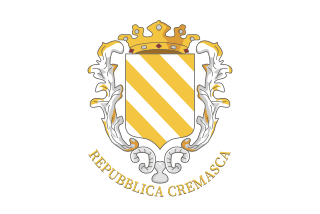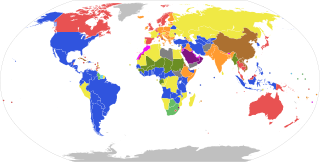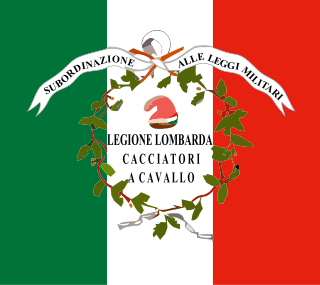
The Treaty of Campo Formio was signed on 17 October 1797 by Napoleon Bonaparte and Count Philipp von Cobenzl as representatives of the French Republic and the Austrian monarchy, respectively. The treaty followed the armistice of Leoben, which had been forced on the Habsburgs by Napoleon's victorious campaign in Italy. It ended the War of the First Coalition and left Great Britain fighting alone against revolutionary France.

The Cisalpine Republic was a sister republic of France in Northern Italy that existed from 1797 to 1799, with a second version until 1802.

The Italian Republic was a short-lived (1802–1805) republic located in Northern Italy. Napoleon Bonaparte served as president and its capital was Milan.

The Cispadane Republic was a short-lived client republic located in northern Italy, founded in 1796 with the protection of the French army, led by Napoleon Bonaparte. In the following year, it was merged with the Transpadane Republic to form the Cisalpine Republic. The Cispadane Republic was the first Italian sovereign State to adopt the Italian tricolour as its flag.

The Transpadane Republic was a sister republic of France established in Milan from 1796 to 1797.

The Republic of Crema was a revolutionary municipality in Lombardy, which was created when the French Army entered Crema on 28 March 1797. It ruled the local affairs of the city and its environs, which previously were a Venetian exclave in the Duchy of Milan. The municipality entered then into the Cisalpine Republic in July 1797.

A sister republic was a republic established by the French First Republic or by local revolutionaries during the French Revolutionary Wars. These republics, though nominally independent, relied heavily on France for protection, making them more akin to autonomous territories rather than independent states. This became particularly evident after the declaration of the French Empire, when several states were annexed, and the remaining turned into monarchies ruled by members of the Bonaparte family.

The Polish Legions were several Polish military units that served with the French Army in the Napoleonic era, mainly from 1797 to 1803, although some units continued to serve until 1815.

A directorial republic is a country ruled by a college of several people who jointly exercise the powers of a head of state and/or a head of government.

The Flags of Napoleonic Italy were the green, white and red tricolour flags and banners in use in Italy during the Napoleonic era, which lasted from 1796 to 1814. During this period, on 7 January 1797, the green, white and red tricolour was officially adopted for the first time as a national flag by a sovereign Italian state, the Cispadane Republic. This event is commemorated by the Tricolour Day.
The Republic of Brescia was a temporary French client republic in Italy. Established March 18, 1797, in the wake of the French occupation of Brescia and Bergamo, it became part of the Cisalpine Republic November 20, 1797.
The Republic of Bergamo was an ephemeral revolutionary client republic, created on 13 March 1797 by the French army to rule the local administration of Bergamo and its province, during the dissolution of the Republic of Venice. With the Preliminary of Leoben, France and Austria agreed the end of the multi-centennial Venetian rule over the territory between Adda River and Oglio River, together with the Austrian occupation of Istria and Dalmatia.
The siege of Mantua (1799) was a four-month effort by the Austrian army to regain a presence in northern Italy after being excluded from that region by Napoleon Bonaparte through the successful French siege of Mantua in 1797. In April 1799, the Austrians placed a military blockade around Mantua as part of the War of the Second Coalition with the intent of withering the French by attrition. While the diminishing food supplies and losses weakened the French army, the Austrians received reinforcements and attacked on 4 July 1799. By the end of the month, the French agreed to surrender.

The Venetian Province was the name of the territory of the former Republic of Venice ceded by the French First Republic to the Habsburg monarchy under the terms of the 1797 Treaty of Campo Formio that ended the War of the First Coalition. The province's capital was Venice.

The French invasion of Switzerland occurred from January to May 1798 as part of the French Revolutionary Wars. The independent Old Swiss Confederacy collapsed from the invasion and simultaneous internal revolts called the "Helvetic Revolution". The Swiss ancien régime institutions were abolished and replaced by the centralised Helvetic Republic, one of the sister republics of the French First Republic.
The Constitution of the Cisalpine Republic, was the first constitution of the Cisalpine Republic, a sister republic of France under Napoleon Bonaparte, roughly comprising the modern-day northern regions of Lombardy and Emilia-Romagna. It came into effect on 20 messidor V.

Tricolour Day, officially National Flag Day, is the flag day of Italy. Celebrated on 7 January, it was established by Law 671 on 31 December 1996. It is intended as a celebration, though not a public holiday. The official celebration of the day is held in Reggio Emilia, the city where the Italian tricolour was first adopted as flag by an Italian sovereign state, the Cispadane Republic, on 7 January 1797.

The Lombard Legion was a military unit of the Cisalpine Republic which existed from 1796 until the Republic's fall in 1799; but despite the downfall of this sister republic, the Cisalpine troops continued to serve France. The Lombard Legion was the first Italian military department to equip itself, as a banner, with an Italian tricolor flag.
Gian Galeazzo Serbelloni was a Milanese nobleman, notable as president of the founding Directory of the Cisalpine Republic and as preceptor to the Milanese poet Giuseppe Parini.












